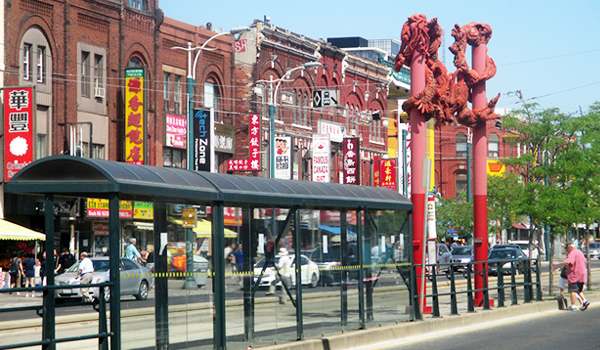与时俱进的多伦多唐人街反映了华裔在加拿大的困境、挑战和希望
The Toronto Chinatown keeps pace with the times, reflects the plight, challenges and hope of Chinese in Canada
来源: Bob Mok

这是关于多伦多多伦多华埠商业促进区(CBIA)和多伦多唐人街的系列文章的第二部分。如要阅读第一篇文章,请点击:http://chinesenewsgroup.com/news/666879
This is the second part of a series of articles on the Toronto Chinatown Business Improvement Area (CBIA) and Toronto Chinatown. For the earlier article, click on: http://chinesenewsgroup.com/news/666879
许多多伦多唐人街的居民是来自亚洲的后裔或移民,包括中国,香港,台湾,印度,巴基斯坦,越南,老挝,柬埔寨和其他东南亚国家。多伦多的唐人街可以追溯到19世纪70年代后期。当时,一名叫Sam Ching的华人开了第一家生意。他的洗衣店位于9 Adelaide E.
Many of the Toronto Chinatown residents are descendants or immigrants from Asia: China, Hong Kong, Taiwan, India, Pakistan, Vietnam, Laos, Cambodia, and other Southeast Asian countries. Toronto’s Chinatown can be traced to the late 1870s, with the opening of the first Chinese business, owned by Sam Ching. His laundry wash was located at 9 Adelaide E.

为了提高生活质量而来到多伦多的许多中国人都惊讶地看到中国人在就业,生活和整体待遇的不平等。当华裔从家乡移民到多伦多时,由于系统性种族歧视,他们中的许多人无法找到工作。由于英语沟通能力极差,他们必须利用自己有限的技能来赚取收入。因此,华裔移民人口的增长缓慢。到1881年,只有10个中国人住在多伦多。
Many Chinese people who had come to Toronto for a better quality of living were surprised to see the inequality in jobs, living and overall treatment of the Chinese. When the Chinese emigrated from their homelands to Toronto, many of them were not able to find jobs because of systemic discrimination. They have to use their limited skills to earn an income, constantly impeded by their inability to communicate properly in English. The growth of the Chinese population was sluggish and by 1881, there were only 10 Chinese people left residing in all of Toronto.
旧唐人街的商店数量在19世纪末至20世纪初逐渐增长,并在伊丽莎白街上形成了从女皇西街北至登打士西街的华裔圈。该地区的商业种类有限,主要是洗衣房,餐馆和干货店。在20世纪20年代,更多的华裔在此定居,并在未来几十年中不断上升。华裔居民在伊丽莎白街和邻近较小的街道上开发了他们的商店,协会,政治团体,媒体,剧院和歌剧院。到20世纪40年代,多伦多唐人街的人口在全加居第三位,仅次于不列颠哥伦比亚省的维多利亚和温哥华。
The number of stores in old Chinatown grew over the years of the late 1800s-early 1900s, forming a little enclave on Elizabeth St, from Queen St. W north to Dundas St. W. The variety of businesses in the area was limited, consisting primarily of laundry washes, restaurants and dried goods shops. Settlement by the Chinese developed in the 1920s and was firmly established at this location for several decades. The Chinese residents had developed their shops, associations, political groups, media networks, theatres and opera houses in the area of Elizabeth St, and along the smaller streets adjacent. By the 1940s, the population in Toronto’s Chinatown was the third largest, after cities Victoria and Vancouver, both located in British Columbia.

当多伦多要盖新的市政厅进入讨论议题后,正在稳健发展的伊丽莎白街却面临着湮灭的命运。这座新的为城市官员和议员们建造的大楼选中了路易莎和伊丽莎白街。这意味着许多中国商家和住宅将被拆除,以便为一座宏伟的新建筑腾出空间。一个致力于保护该地区商店和住宅的委员会于1968年成立,由Jean Lumb领导。 Lumb女士后来因为她对该项目的杰出奉献而赢得了加拿大勋章。拆迁使唐人街的面积缩小了三分之二,空出的地段被用于建造新的市政厅和菲利普斯广场。
The stable and developed Elizabeth St. faced annihilation when discussion of a new City Hall arose. This new building for city officials and councillors was to be built at Louisa and Elizabeth Streets. This meant many Chinese businesses and residences would be demolished to make way for a grand new building. A committee, dedicated to the preservation of shops and residences along this area was founded in 1968 and led by Jean Lumb. Ms. Lumb later won the Order of Canada for her dedication and commitment to this project. Demolition decreased the area of Chinatown by two thirds and this space was used for new City Hall and Nathan Phillips Square.

我于1968年抵达多伦多,在多伦多共找到4家中餐馆。其中三个位于市政厅附近。这些餐馆点心做得令人难以置信的糟糕 - 没有虾的虾饺的个头是你通常所见虾饺的3倍,而烧卖呢?个头就像手榴弹,叉烧包子足有一个碗大。
I arrived in Toronto in 1968 and found a total of 4 Chinese restaurants in all of Toronto. Three of them were located near City Hall. Dim Sum food was unbelievably bad – Shrimp dumplings without shrimps and at 3 times the regular size, Siu Mai was the size of hand grenades, and BBQ pork buns the size of soup bowls.
新市政厅完工后,旧唐人街的土地价格飙升,很多人无法承担得起而搬走。因此,他们从伊丽莎白街搬到登打士西街,也就是贝街和登打士交界的地段。如今,尽管许多华人组织已经撤离该地区,但此地段仍有许多华人旧址的迹象。
After the erection of the new City building, the prices for the land in the old Chinatown skyrocketed and there were not many people that could afford to live in the same area they once had. Thus, they moved from Elizabeth St, onto Dundas Street W, from the intersection of Elizabeth Streets all the way to Bay and Dundas. Nowadays, there are still many signs on these old buildings, although many of the associations have vacated the area.

今天,西唐人街或称中区唐人街/中区华埠/中国城是旧唐人街的一部分。这个唐人街是从前述的地段搬到Spadina大道和登打士西街交界后形成的,是大多伦多地区的五个唐人街之一(另外4个是东区唐人街,万锦/列治文山,士嘉堡和密西沙加唐人街)。如果您沿着伊丽莎白街(最老的唐人街)漫步至登打士街,你仍然可以看到老唐人街的痕迹。这些空置的老式建筑是多伦多历史的写照,诉说着华人在发展这个城市中所面临的困境和挑战。
Today, the West Chinatown or is a portion of Old Chinatown that has been relocated to Spadina Ave. and Dundas St. W and is one of five Chinatown ‘hubs’ of the GTA (the other 4 being East Chinatown, Markham/Richmond Hill, Scarborough, and Mississauga). If you take a walk through Old Chinatown, along Elizabeth St, up to Dundas St. W, there are still many signs that remain on their old buildings and while vacated, are remnants and indicators of Toronto’s history and the challenges the Chinese faced when developing in this city.
未来多伦多中区唐人街将来会是怎样?多年来,这一地区的建筑高度受到限制,Spadina大道上所有百年历史的建筑都没有太多变化。最近,建筑高度的限制逐渐放宽,高层建筑将替换百年排屋,那些老华侨们们也正在被多伦多大学及其许多年轻的亚洲学生取代。年轻的企业家正在开拓着迎合年轻一代需求并能振兴该地区的企业。该地区还将迎来新的变革,并走向更加充满活力的未来。
What is going to happen to Toronto Chinatown (Downtown) in future? For many years, building heights were restricted and all the hundred year old buildings on Spadina Avenue stood without too many changes. Recently, height restrictions are slowly lifted and tall buildings will encroach on the century old row houses. The University of Toronto with its many young Asian students are replacing the older and disappearing generation of Chinese who once lived there. Young entrepreneurs are starting up businesses catering to the younger generations and revitalizing the area. The area will yet manage another metamorphosis towards a more vibrant future.

作者按:本文的历史资料来自陈籍强和其夫人,The Chinese in Toronto from 1878: From Outside to Inside the Circle,Toronto: National Heritage, 1987网络版。
Note: Credits-Source for history of Chinatown information: Leo Chan, Arlene Chan. The Chinese in Toronto from 1878: From Outside to Inside the Circle. Toronto: National Heritage, 1987. Online.

网友评论
网友评论仅供其表达个人看法,并不表明大中资讯网立场。评论不可涉及非法、粗俗、猥亵、歧视,或令人反感的内容,本网站有权删除相关内容。